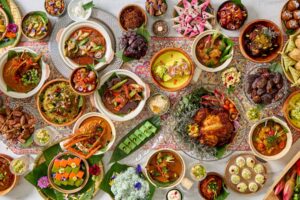The menu was like a trip to the chef’s hometown, where each bite told a story.

For those not in the know, the Basque Country is located in the western Pyrenees and straddles the border between France and Spain on the coast of the Bay of Biscay. The origin of the Basque Country dates back centuries when residents lived off their livestock on the Pyrenees mountains.
As they moved seaward, marine activities became an integral part of Basque culture. The terrain provided the Basque people with rich bounties, and they knew how to make use of it.
Hailing from San Sebastian, Spain, Executive Chef Pedro Samper has brought his wealth of knowledge and Michelin Star experience to The St. Regis Kuala Lumpur. Having honed his skills most notably with Chef Martin Berasategui who holds eight Michelin stars in total, Chef Pedro’s meticulous preparation and presentation of each dish gave us glimpses of his hometown.
The menu for the night, The Basque, was his take on traditional Basque cuisine and is exclusively curated for The Brasserie.
First Course
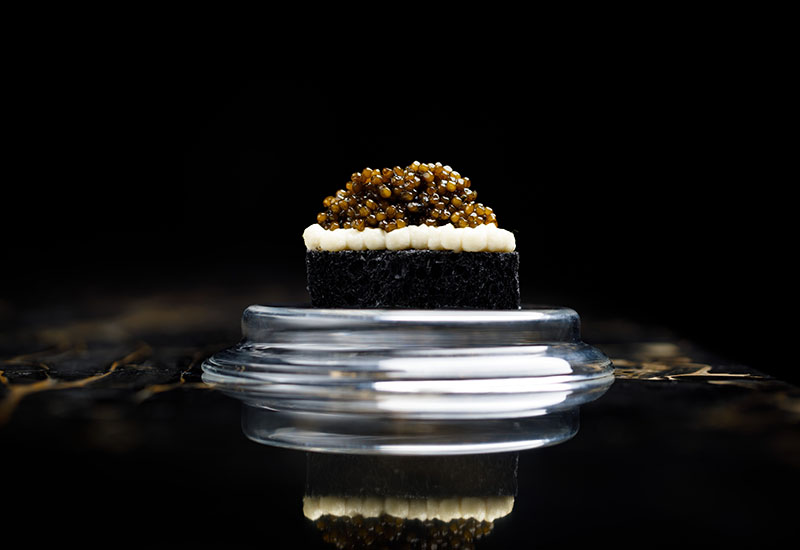 The night opened with Bacalao ‘Brandada’ & Caviar, Cod Brandade with Caviar and Charcoal Brioche. Tiny glistening black pearls of caviar sat on the cloudlike cod brandade (an emulsion of salt cod and olive oil) atop of a crispy bed of charcoal brioche. It was a play of different textures, with the salty beads of caviar and the delicate taste of brandade paired with the crunch of the brioche.
The night opened with Bacalao ‘Brandada’ & Caviar, Cod Brandade with Caviar and Charcoal Brioche. Tiny glistening black pearls of caviar sat on the cloudlike cod brandade (an emulsion of salt cod and olive oil) atop of a crispy bed of charcoal brioche. It was a play of different textures, with the salty beads of caviar and the delicate taste of brandade paired with the crunch of the brioche.
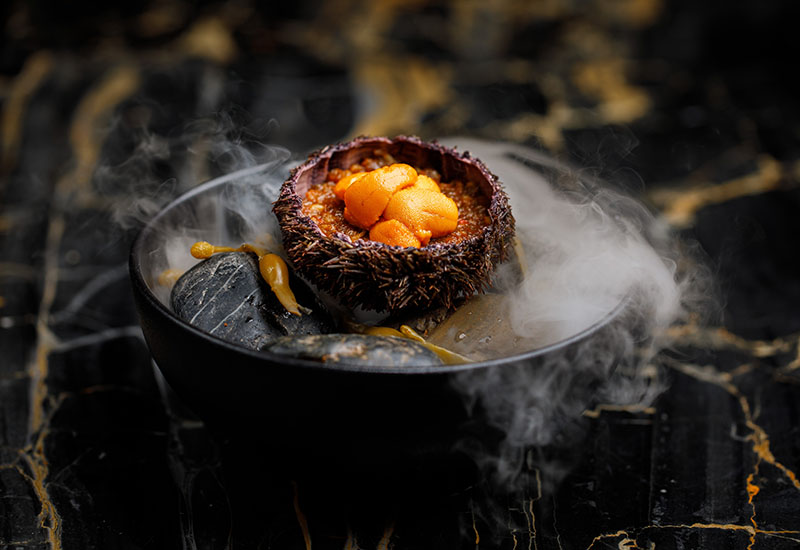 When the fanciest dish of the night, Txangurro & Sea Urchins, was served, the presentation of the dish was a masterful take of what should have been a simple stew. The San Sebastian Style Crab stew was served in a sea urchin shell, with creamy, bright orange Hokkaido sea urchin enticing the first bite. The creamy, sweet taste of fresh sea urchin or uni, amplified the rich stew. The umami from the uni was a perfect complement to the soft strands of crab meat in the stew.
When the fanciest dish of the night, Txangurro & Sea Urchins, was served, the presentation of the dish was a masterful take of what should have been a simple stew. The San Sebastian Style Crab stew was served in a sea urchin shell, with creamy, bright orange Hokkaido sea urchin enticing the first bite. The creamy, sweet taste of fresh sea urchin or uni, amplified the rich stew. The umami from the uni was a perfect complement to the soft strands of crab meat in the stew.
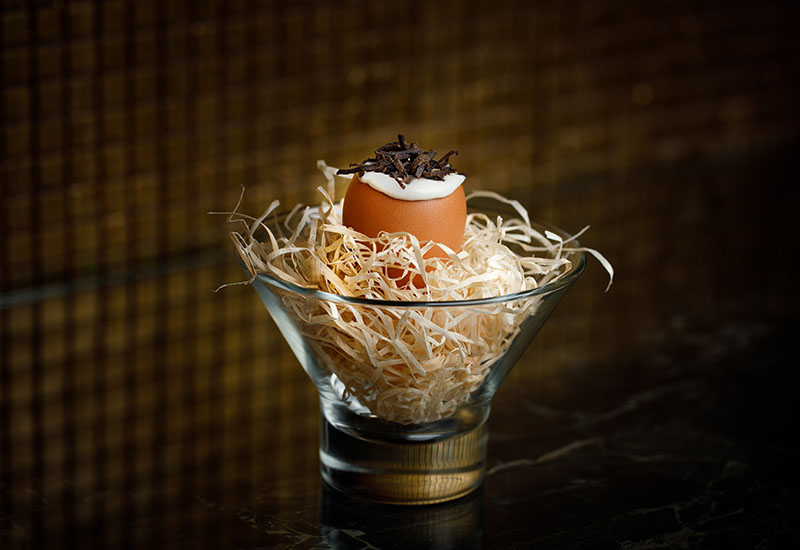 Tortilla de Patatas ‘Udaberri’ was no usual potato omelette. It was a delicate dish of gentle foam, on top of a bed of potatoes, all encased within an eggshell. Black truffles shaving on top of it brought a touch of luxury to the dish. Each teaspoon was a burst of different flavours; there was the creaminess from the egg, firmness from the potatoes and the paper smokiness from the truffles.
Tortilla de Patatas ‘Udaberri’ was no usual potato omelette. It was a delicate dish of gentle foam, on top of a bed of potatoes, all encased within an eggshell. Black truffles shaving on top of it brought a touch of luxury to the dish. Each teaspoon was a burst of different flavours; there was the creaminess from the egg, firmness from the potatoes and the paper smokiness from the truffles.
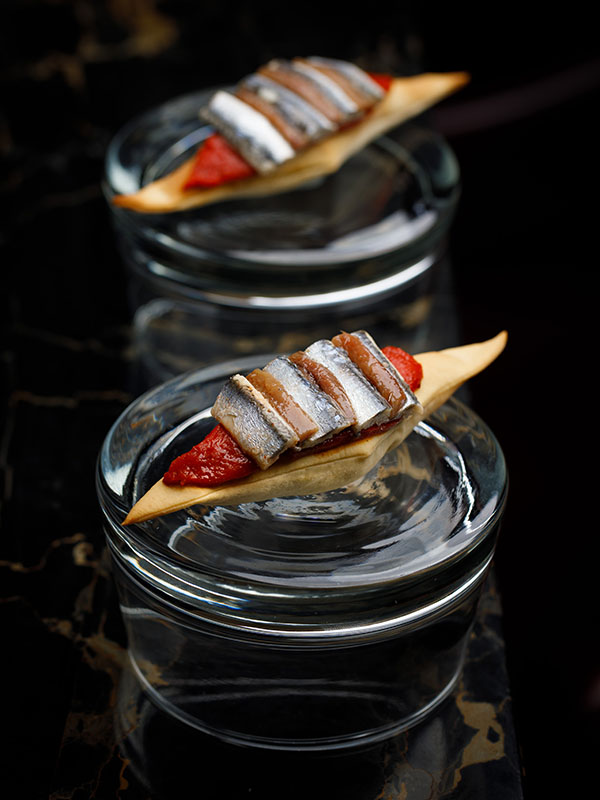 Chef Pedro mentioned that the Antxoa & Boqueron de Getaria was his personal favourite of the four, and we can see why. With Basque anchovies on top of the crusty sourdough filled with ensaladilla (a mixed salad of tuna and mayonnaise), each bite brought us to coastal Spain, right back to San Sebastian. Chef Pedro captured the essence of his hometown in this dish.
Chef Pedro mentioned that the Antxoa & Boqueron de Getaria was his personal favourite of the four, and we can see why. With Basque anchovies on top of the crusty sourdough filled with ensaladilla (a mixed salad of tuna and mayonnaise), each bite brought us to coastal Spain, right back to San Sebastian. Chef Pedro captured the essence of his hometown in this dish.
Second Course
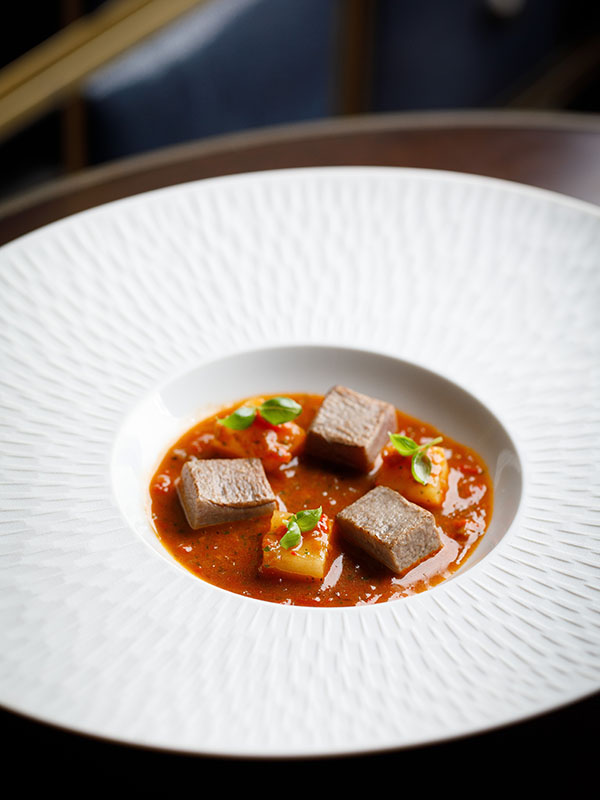 In Basque language, Marmitako, a popular dish from Basque coast villages, translates to “from the pot.” Traditionally eaten as a stew, the main ingredients are tuna, tomatoes, onion, peppers, garlic and potatoes. The tuna was fatty, and with every bite, it just melted in the mouth. The seared tuna was mild, tender, and oily, and in the stew, it was perfect with the well-done potatoes.
In Basque language, Marmitako, a popular dish from Basque coast villages, translates to “from the pot.” Traditionally eaten as a stew, the main ingredients are tuna, tomatoes, onion, peppers, garlic and potatoes. The tuna was fatty, and with every bite, it just melted in the mouth. The seared tuna was mild, tender, and oily, and in the stew, it was perfect with the well-done potatoes.
Third Course
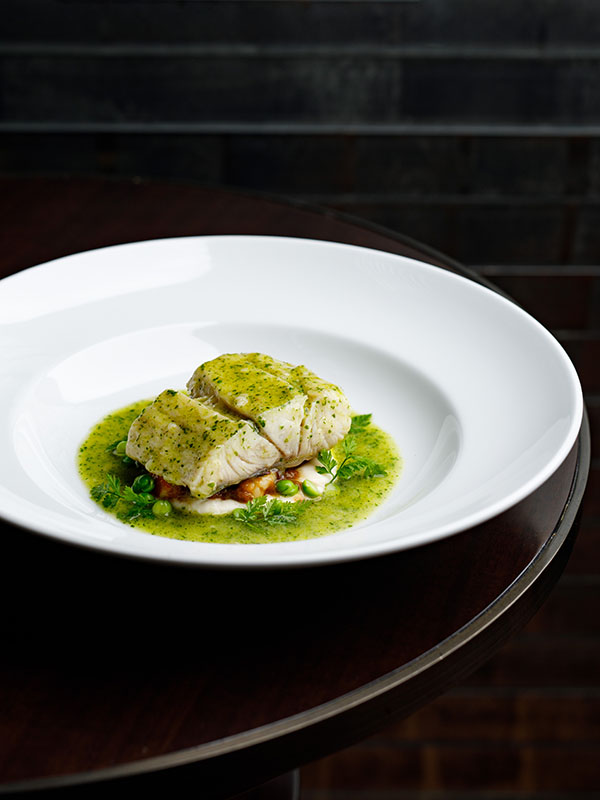 After a line of exciting dishes, the snapper in ‘Salsa Verde’ fell a little flat. While the snapper was robust, firm and sweet on top of a bed of prawns, green peas and clam juice, the flavours were one-dimensional. It was still a tasty dish, just that nothing, in particular, stood out.
After a line of exciting dishes, the snapper in ‘Salsa Verde’ fell a little flat. While the snapper was robust, firm and sweet on top of a bed of prawns, green peas and clam juice, the flavours were one-dimensional. It was still a tasty dish, just that nothing, in particular, stood out.
Fourth Course
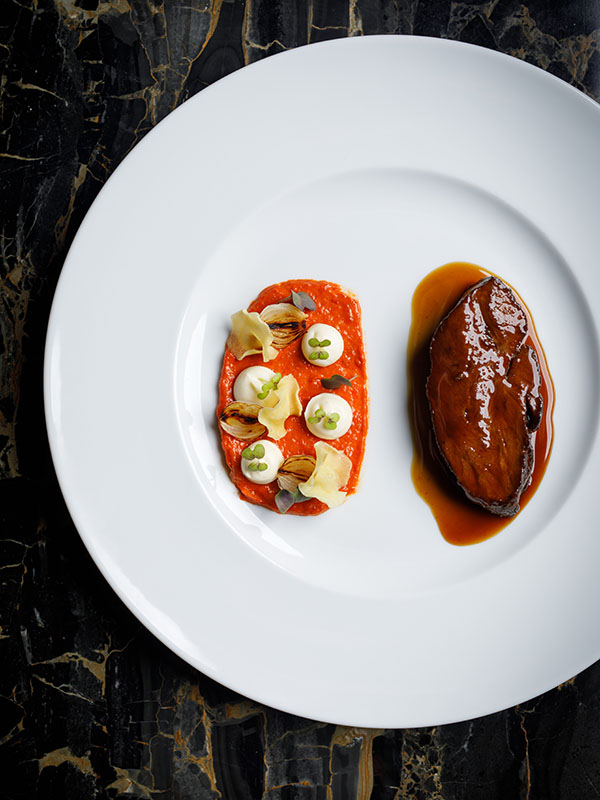 After a vast array of seafood dish, Carrilleras was a striking contrast. Chef Pedro told us that the dish of beef cheeks was a page from his childhood memories. And he did justice to those memories: the beef cheeks were rendered to almost buttery silkiness. The flavours were strong, with delicious briny gamey-ness that was much welcomed after all the sweet-salty taste of seafood.
After a vast array of seafood dish, Carrilleras was a striking contrast. Chef Pedro told us that the dish of beef cheeks was a page from his childhood memories. And he did justice to those memories: the beef cheeks were rendered to almost buttery silkiness. The flavours were strong, with delicious briny gamey-ness that was much welcomed after all the sweet-salty taste of seafood.
Fifth Course
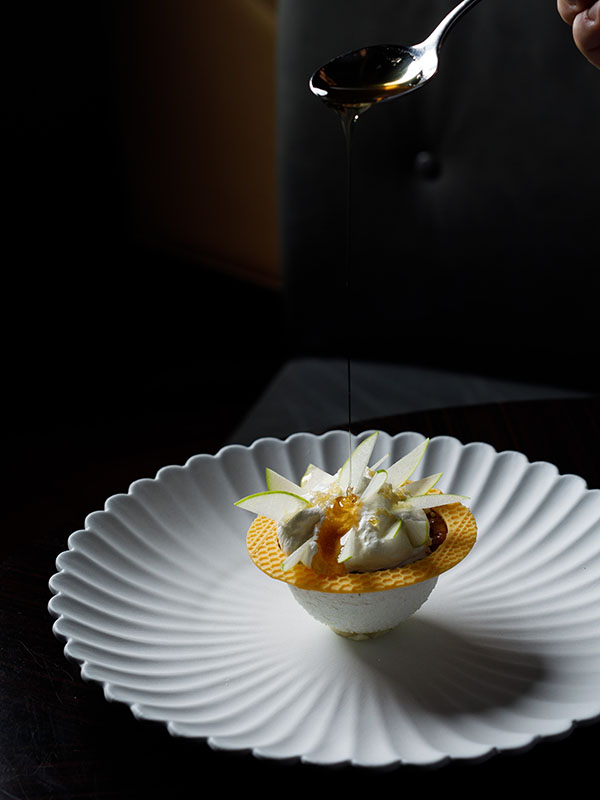 We could not wait for dessert as Mamia is probably the most known Basque dessert, traditionally made from sheep milk curd served with honey and nuts. It did not disappoint – it was rich and sweet from smoked sheep’s milk and honeycomb. Combined with the tartness of the green apples that prevented it from getting too cloying, it had a right balance of textures and taste.
We could not wait for dessert as Mamia is probably the most known Basque dessert, traditionally made from sheep milk curd served with honey and nuts. It did not disappoint – it was rich and sweet from smoked sheep’s milk and honeycomb. Combined with the tartness of the green apples that prevented it from getting too cloying, it had a right balance of textures and taste.
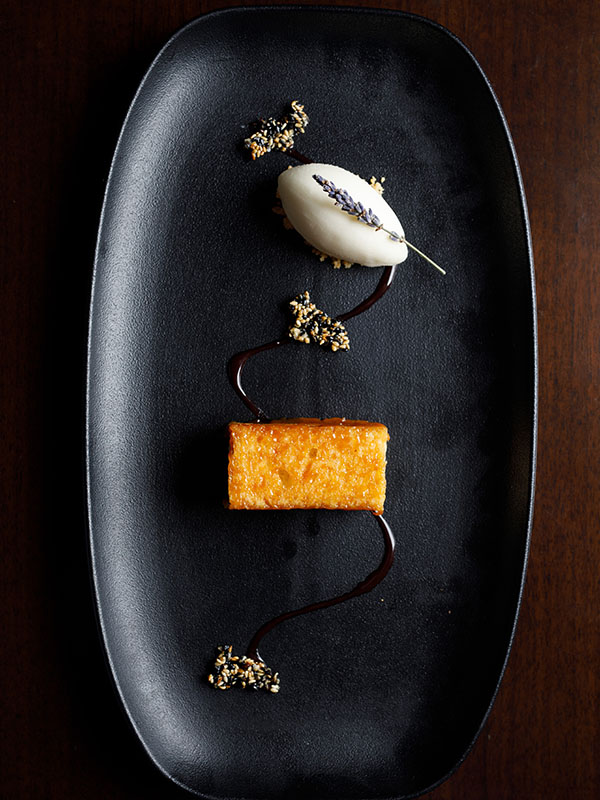 The Caramelised ‘Torrija’ was a sophisticated Basque version of the humble bread pudding. The bread cube was soaked in milk and caramelised, keeping it from getting too soggy while retaining the liquid. It was served with fragrant lavender ice cream and sesame crumbles for more texture play.
The Caramelised ‘Torrija’ was a sophisticated Basque version of the humble bread pudding. The bread cube was soaked in milk and caramelised, keeping it from getting too soggy while retaining the liquid. It was served with fragrant lavender ice cream and sesame crumbles for more texture play.
Sixth Course
The night drew to a close with the Tejas y Cigarrillos de Tolosa, which was tuille shaped like a cigar with almonds and a delectable cube of chocolate. It was simple, yet sinful. The tuille was buttery and crispy and the chocolate was decadent and not too sweet.
The Brasserie has again raised the bar with masterful plating and complex flavours of a vibrant menu. Do look out for their chef’s menu, usually at the end of each month. Drop by their official website for more information.
Images courtesy of St Regis.




